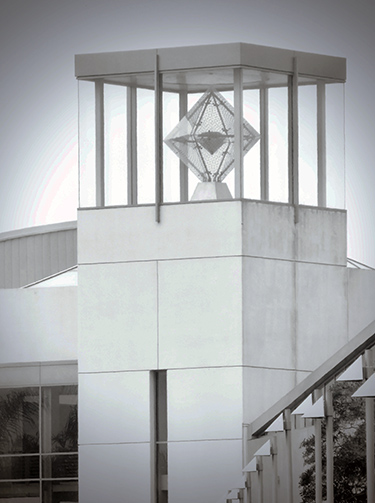 Editor’s Note: This is the 20th chapter in Volume 3 of Publisher and Editor Donald H. Harrison’s 2022 trilogy, “Schlepping and Schmoozing Along the Interstate 5.” All three books as well as others written by Harrison may be purchased from Amazon.com.
Editor’s Note: This is the 20th chapter in Volume 3 of Publisher and Editor Donald H. Harrison’s 2022 trilogy, “Schlepping and Schmoozing Along the Interstate 5.” All three books as well as others written by Harrison may be purchased from Amazon.com.
Schlepping and Schmoozing Along the Interstate 5, Volume 3, Exit 48 (Cannon Road): Gemological Institute of America
From Northbound Interstate 5, take the Cannon Road exit, turn right toward Legoland, turn right again onto Legoland Drive, then bear right onto Armada Drive. The Gemological Institute of America is at 5345 Armada Drive, Carlsbad.


CARLSBAD, California — The Gemological Institute of America (GIA) houses both a museum for the public and a school for jewelry industry personnel. Here the public can learn about the process by which shiny and colorful objects in nature become centerpieces in treasured family keepsakes. Here also is where budding jewelers learn how to measure, inspect, and grade jewels according to worldwide standards.
Giants in the jewelry industry serve on GIA’s board of directors. Fellow directors elected Helene Fortunoff as their chair from 2005 to 2008, quite an honor for someone who back in the 1960s had gone to GIA’s school to learn about diamond evaluation and appraisals.
Fortunoff eventually headed a multimillion-dollar business based in New York and northern New Jersey, for which she hired mostly women to buy jewelry and gems from manufacturers and suppliers around the world. The daughter of Tillie and Samuel Finke (ne Finkelstein), she had graduated with high honors in 1953 from New York University’s School of Commerce, and married classmate Alan Fortunoff that same year. Soon thereafter, she joined his nine-store family business in Brooklyn, which had been started by his parents, Max and Clara Fortunoff.
Joanne Palmer, in a comprehensive profile for the New Jersey Jewish News, wrote that Max and Clara assigned to Alan, his brother Lester and his sister Marjorie different departments to oversee. As spouses came into the family, they also were assigned departments to run. Alan got silver flatware and serving dishes. Initially, Helene was put in charge of shower curtains, bathmats, and luggage. Lester sold garden and outdoor equipment, while Marjorie Fortunoff Mayrock and her husband Harry covered every interior part of the home except kitchens. Clara retained pots and pans for herself. Max focused on window shades and curtains. The founders continued to work almost to the days they died.
When Max and Clara semi-retired, they sold elements of the Fortunoff stores to their children and spouses in separate conceptual parcels, so that they each owned specialty departments. On Helene’s suggestion, she and Alan expanded their business from silver trays and cutlery to jewelry. After opening new stores in Long Island, the family inaugurated a 150,000-square-foot flagship store in midtown Manhattan. They also expanded to several locations in New Jersey and in Westchester County, New York. Esther Fortunoff-Greene, Helene and Alan’s daughter, recalled that at the Manhattan store, “my mother ended up with 20 showcases of jewelry and my father had this giant wall of flatware. It was an incredible thing.”
As demand for silver serving pieces and cutlery waned, the jewelry part of the business expanded.
Many of the companies that wholesale jewels to retail operations like hers were staffed by ultra-Orthodox Jewish men, whose observance of modesty precluded them from shaking her hand, or in some cases even looking at a woman to whom they were not married. On such buying excursions, Helene asked her husband Alan to accompany her, even though she was far more knowledgeable about jewelry than he was.
Eventually, Helene and her staff of women buyers traveled to various places in the world to buy their gems direct from “the source,” touting the elimination of middlemen in the company’s advertising. According to daughter Esther in the New Jersey Jewish News article, Helene’s preference for women buyers and sales staff was because “she could relate to women better. And she also knew in her heart — and I think this is the key– that women understand jewelry better than men do. They are the ones who are wearing it, and who are picking it, even though sometimes men choose for women. She knew that women would have more of a natural ease with the product, as opposed to having learned it. I always knew that this was part of our success. Most of the staff at most other jewelry stores were men.”
The female sales personnel in the Fortunoff stores, in some cases, “were women who had never worked before,” Esther told New Jersey Jewish News. “Some of them were teachers and would go home, feed their families, and come in and work the nightshift.”
Helene, herself, was a working mother, allowing herself only eleven days between giving birth and going back to work. “I always wanted a family and a career, and no one ever told me I couldn’t have both” Helene once told The New York Times, according to an obituary written by Katharine Q. Seelye in November 2021. “I made $50 a week and paid the baby nurse $60. But I knew within a period of months I’d be making $100 a week. I tell women, if their childcare isn’t adequate and they are going to worry, and it will affect their job performance. It’s better to get the help you need and maybe come up short the first year. In the long run, you definitely come out ahead.”
Helene often took her children to work so that they might someday step into the business.
The National Jeweler, a trade publication, noted that Fortunoff ‘s carried jewelry by women designers whenever possible and offered split shifts and flex time to women who had families to take care of.”
Upon learning of Helene Fortunoffi’s death at age 88 in November 2021, Susan Jacques, The GIA president and CEO, commented from Carlsbad, California, that “Helene’s business acumen, taste and talent made her a nationally recognized leader in the industry, well beyond the geographic footprint of the Fortunoff retail stores in and around New York City. Those same qualities and her pioneering spirit opened opportunities for generations of women, including me, to bring their diverse voices, talents, passion and leadership to the global gem and jewelry industry.”
Jacques noted that Helene had served as a member of the board of governors from 1998 to her retirement in 2008.
In addition to Helene’s leadership of GIA, The National Jeweler reported that she was a founding member of the Women’s Jewelry Association, and later that organization’s president. She was also “the first woman member of the now-defunct US. Carat Club and the first woman indicted into National Jeweler’s Retail Hall of Fame (Class of 1990). She was knighted in Italy for her work promoting Italian jewelry … received the American Gem Society’s triple Zero Award, and in January 2006, was honored with the Gem Award for Lifetime Achievement with the Jewelry Information Center, which has since merged with Jewelers of America.”
The U.S. Carat Club had been started by the de Beers group of South Africa, which hosted Helene and some of her women buyers on tours of gold and diamond mines. Later, she was accompanied to the Gem Awards by actress Lauren Bacall, who since 1979 had served as a Fortunoff spokesmodel in full-page newspaper advertisements. In The New York Times obituary of Helene, some of Bacall’s saucy advertising lines were remembered. In one Bacall stated, “There’s nothing like the blaze of diamonds to warm a winter’s evening.” In another, she declared, “If you find me drowning in freshwater pearls, don’t rescue me.”
Along with their business successes, Helene and Alan Fortunoff built a reputation as philanthropists both in the Jewish and general communities. Women’s Wear Daily reported that she was a past board chair of Hofstra University. “She was honored by the UJA Federation of New York, Diamond and Jewelry Division,” as well as by a similarly named division of ORT, the daily reported. “She was a charter member of the UJA Women of Distinction and a Lion of Judah of that organization. In addition, Mrs. Fortunoff served as an advisory board member of the Women Presidents Organization.” Another favorite charity was the North Shore Child and Family Guidance Center in Roslyn Heights, New York.
She was also a supporter of the nascent Israeli jewelry industry, creating a jewelry fair in Jerusalem in 1977. When her sister Marjorie died in 1982, the Fortunoffs established a center for Russian studies at Hebrew University.
Her husband, Alan, who had predeceased her in 2000, had endowed the Fortunoff Video Archive for Holocaust Testimonies at Yale University in memory of his parents, Max and Clara. Helene, who became president upon his death of Fortunoff Fine Jewelry and Silverware Inc., continued to support the archive through her lifetime. Additionally, she was a major contributor to the Lustgarten Foundation, which sponsored pancreatic cancer research, and the Mount Sinai Medical Center Foundation.
In 2005, the Fortunoff family sold a majority stake in the company to private investors. After Helene retired a mutual friend introduced Helene to Robert Grossman, whom she married in 2006, settling in Florida. Together the couple built up a formidable collection of British ceramics and porcelain, some of which they donated to the New York Metropolitan Museum of Art, Yale University, the Art Institute of Chicago, and the Wolfsonian at Florida International University.
Besides her second husband and daughter Esther, surviving members of her family included four children, Andrea, Rhonda, Ruth, and David. A son, Louis had predeceased her. Nine grandchildren and one great-grandchild are part of her legacy.
*
Donald H. Harrison is publisher and editor of San Diego Jewish World. He may be contacted via sdheritage@cox.net
Sue Cherlin wrote: Your article on Fortunoffs, is a story I can relate to. I grew up on Long Island and knew of Fortunoffs, department store. I bought my wedding ring there. Several of my silver settings, from family members were purchased there too. I am able to visualize that store clearly. Needless to say, I enjoyed the article.
“Initially, Helene was put in charge of shower curtains, bathmats, and luggage.”
This sentence alone made the entire story worth reading. It shows the depth of the research that went into it. My compliments.